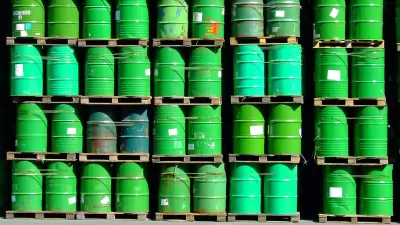Research has shown that the world's largest land use, grazing, holds enormous potential when linked with composting, to dramatically reduce the carbon content of the atmosphere through sequestration while concurrently restoring degraded rangeland.
The largest component of solid waste—food waste (according to this EPA pie chart)—may be one of the most effective tools to fight climate change if municipally composted and applied on rangeland as San Francisco has been doing since 2009. However, they don't have much company.
"In 2010, 97% of America's 35 million tons of food waste went into landfills," as noted here last year, Plus, we also pointed out here last year that according to "a new study from the U.N. Food and Agriculture Organization, food waste Is third-largest greenhouse gas source."
"The research showed that if compost from green waste — everything from household food scraps to dairy manure — were applied over just 5 percent of (California)'s grazing lands, the soil could capture a year’s worth of greenhouse gas emissions from California’s farm and forestry industries," writes Carolyn Lochhead of the San Francisco Chronicle.
Experiments on grazing lands in Marin County and the Sierra foothills of Yuba County by UC Berkeley bio-geochemist Whendee Silver showed that a one-time dusting of compost substantially boosted the soil’s carbon storage.
The application of compost helps "(p)lants pull carbon dioxide from the air through photosynthesis and transfer a portion of the carbon to the soil through their roots." Ohio State University provides a more elaborate description under the "Carbon and Soil Organic Matter" section of their factsheet [PDF].
"Grazing is the single largest land use on the planet, and most grazing lands are degraded, meaning they have lost carbon," writes Lochhead. "That includes California’s coastal and Sierra foothills, where invasive plant species have displaced native perennials that have much deeper roots and store much more carbon."
The University of North Dakota Energy & Environmental Research Center describes the "two major types of CO2 sequestration: terrestrial and geologic:"
- Geologic sequestration is putting CO2 into long-term storage in geologic zones deep underground. It is the method of storage that is generally considered for carbon capture and storage (CCS) projects [from anthropogenic carbon sources].
- Terrestrial (or biologic) sequestration means using plants to capture CO2 from the atmosphere and then storing it as carbon in the stems and roots of the plants as well as in the soil.
"Enter the city of San Francisco, which composts 700 tons of residential and commercial organic waste every day, the largest such operation in the world," writes Lochhead.
“I’ve been in the recycling business for 30-some years here in San Francisco, and this just was much more transformative than the various things we were trying to do to stop putting carbon into the atmosphere,” said Kevin Drew, zero-waste coordinator for San Francisco’s Department of Environment. “To turn around and start taking it out of the atmosphere was a really revolutionary idea, particularly when it was as simple as putting compost on rangeland.”
Composting as a climate mitigation strategy has attracted the attention of "the American Carbon Registry, an organization that certifies (carbon) offsets in California’s cap-and-trade system. On (Oct. 18), it approved one for compost additions to rangeland."
FULL STORY: A sprinkle of compost helps rangeland lock up carbon

Alabama: Trump Terminates Settlements for Black Communities Harmed By Raw Sewage
Trump deemed the landmark civil rights agreement “illegal DEI and environmental justice policy.”

Study: Maui’s Plan to Convert Vacation Rentals to Long-Term Housing Could Cause Nearly $1 Billion Economic Loss
The plan would reduce visitor accommodation by 25% resulting in 1,900 jobs lost.

Why Should We Subsidize Public Transportation?
Many public transit agencies face financial stress due to rising costs, declining fare revenue, and declining subsidies. Transit advocates must provide a strong business case for increasing public transit funding.

Paris Bike Boom Leads to Steep Drop in Air Pollution
The French city’s air quality has improved dramatically in the past 20 years, coinciding with a growth in cycling.

Why Housing Costs More to Build in California Than in Texas
Hard costs like labor and materials combined with ‘soft’ costs such as permitting make building in the San Francisco Bay Area almost three times as costly as in Texas cities.

San Diego County Sees a Rise in Urban Coyotes
San Diego County experiences a rise in urban coyotes, as sightings become prevalent throughout its urban neighbourhoods and surrounding areas.
Urban Design for Planners 1: Software Tools
This six-course series explores essential urban design concepts using open source software and equips planners with the tools they need to participate fully in the urban design process.
Planning for Universal Design
Learn the tools for implementing Universal Design in planning regulations.
Smith Gee Studio
Alamo Area Metropolitan Planning Organization
City of Santa Clarita
Institute for Housing and Urban Development Studies (IHS)
City of Grandview
Harvard GSD Executive Education
Toledo-Lucas County Plan Commissions
Salt Lake City
NYU Wagner Graduate School of Public Service




























